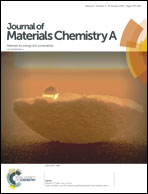Elucidation of the opto-electronic and photoelectrochemical properties of FeVO4 photoanodes for solar water oxidation†
Abstract
Triclinic iron vanadate (n-type FeVO4) thin films were fabricated for the first time by spray pyrolysis and elucidated as a potential photoanode material for solar water oxidation. FeVO4 has an ideal band gap for a photoanode of ∼2.0 eV, which corresponds to a potential solar-to-hydrogen (STH) efficiency of 16%. However, our findings show that the photoelectrochemical performance of FeVO4 is limited by very poor charge carrier separation efficiency in the bulk. Time-resolved microwave conductivity (TRMC) measurements revealed that the low mobility (∼5 × 10−5 cm2 V−1 s−1) and short diffusion length (∼2 nm) of undoped FeVO4 are the main reason for its fast bulk recombination. To overcome the poor charge separation efficiency in the bulk, molybdenum doping was used to enhance its mobility, lifetime, and carrier concentration. Doping with 2% Mo increased the photocurrent density by more than 45% at 1.6 V vs. RHE. Finally, we show that the near-ideal band gap of FeVO4 can be combined with the favorable carrier mobility of BiVO4 in a mixed phase compound, Fe1−xBixVO4, a new photoanode candidate for solar water splitting.



 Please wait while we load your content...
Please wait while we load your content...